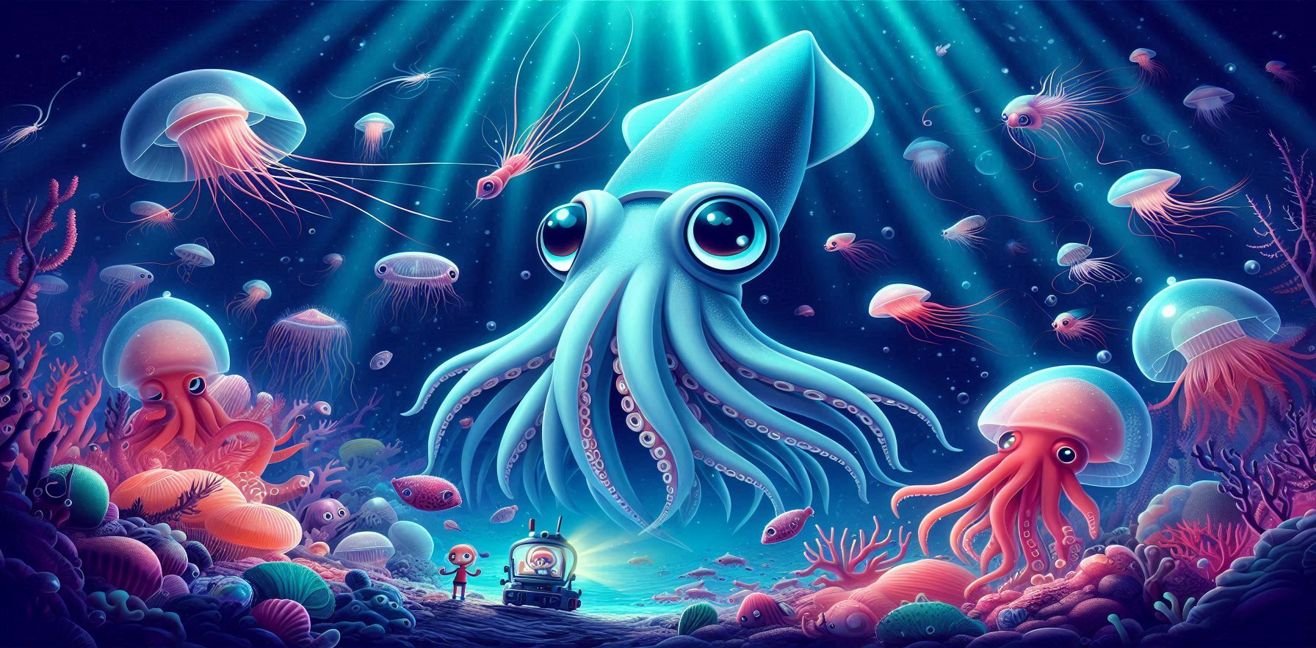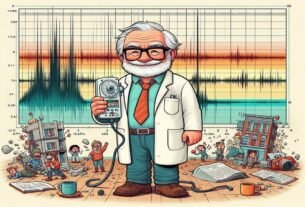Hello, dear science enthusiasts, marine biologists, and ocean adventurers! 🌌
Today, we will dive deep into the dark, high-pressure depths of the oceans to explore the biology, physiology, and adaptation strategies of giant squids (Architeuthis dux) and other colossal deep-sea creatures. Put on your lab coats, prepare your microscopic lenses, and join us on a scientific deep-sea expedition! 🧬🐙💥
🐙 Giant Squid Morphology and Anatomy
Giant squids are deep-sea creatures that can reach 10–13 meters in length, and some reports suggest specimens exceeding 20 meters. Their bodies have evolved to withstand extreme pressure and low temperatures. Key technical details include:
- Mantle (Muscular Body Structure): The mantle forms the main body and contains muscle tissue for jet propulsion. These muscles expel water powerfully, enabling rapid movement.
- Tentacles (Arms and Suckers): They have 8 shorter arms and 2 long hunting tentacles. The long tentacles are highly flexible for capturing prey and self-defense. Suckers provide strong grip and are equipped with small tooth-like structures.
- Eyes: Giant squid eyes measure approximately 27 cm in diameter, capable of maximizing photon capture in low light. These eyes enhance contrast perception and predator/prey detection in deep-sea environments.
🔬 Nervous System and Sensory Perception
Giant squids possess a nervous system comprising both central and peripheral components. Their brains are highly developed for behavior and movement control:
- Optic Lobes: Directly connected to the eyes, optimized for detecting both prey and predators.
- Statocysts: Provide balance and orientation, critical for navigation under high pressure and low-light conditions.
- Bioluminescent Organs (Photophores): Present in some deep-sea squid species, used for communication and camouflage by producing light.
🌊 Extreme Deep-Sea Adaptations
The deep ocean presents extreme challenges for life:
- Pressure: Increases by 1 atmosphere every 10 meters; giant squids can comfortably navigate depths of up to 1000 meters. Their gelatinous body tissues withstand these pressures.
- Temperature: Typically 2–4 °C in deep waters. Metabolic rates are low, conserving energy.
- Low Oxygen: Hemoglobin-like molecules and high blood flow allow survival in oxygen-depleted environments.
- Prey Detection Strategies: Long tentacles, bioluminescence, and exceptional vision enable detection of prey in near-total darkness.
🦐 Other Deep-Sea Giants and Ecological Roles
The deep ocean is not populated solely by giant squids. A variety of other giant organisms maintain ecological balance:
- Nomura Jellyfish (Nemopilema nomurai): Up to 2 meters in diameter and 200 kg in weight. Plays a key role in plankton predation and energy flow.
- Giant Isopod: Can reach 50 cm in length; consumes decaying organic matter, acting as a detritivore in the ecosystem.
- Giant Squat Lobster: Functions as both predator and prey in rocky deep-sea habitats, maintaining ecological balance.
These giants play critical roles in energy transfer and food chain stability within their ecosystems.
🧪 Bioluminescence and Chemical Adaptations
Bioluminescence is employed for camouflage, predation, and communication in deep-sea ecosystems:
- Chemically, light is produced via the luciferin-luciferase reaction.
- Some species control light intensity and color to confuse predators.
- Light production requires metabolic energy; efficient biochemical pathways have evolved to optimize energy use.
🔍 Human Observations and Scientific Research
Observations of giant squids and other deep-sea giants are mostly conducted using remotely operated vehicles (ROVs), sonar, and deep-sea cameras, preserving their natural behavior.
- Behavioral Studies: Document predation, defense, and bioluminescent communication.
- Physiological Studies: Examine metabolism under high pressure, low temperature, and low oxygen.
- Ecosystem Modeling: Aid in understanding energy transfer within deep-sea food webs.
🔍 Conclusion: Scientific Perspective
Giant squids and other deep-sea giants are remarkable examples of biological adaptation. They are:
- Adapted to extreme deep-sea conditions,
- Exceptional in energy efficiency and metabolic optimization,
- And critical for maintaining ecological balance.
Dear readers, the next time you watch a marine documentary or work at a microscope, remember the gigantic eyes, flexible tentacles, and bioluminescent light displays of giant squids. Perhaps one day, you could become a deep-sea biologist uncovering the mysteries of these enigmatic giants! 🌟🐙




